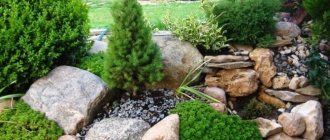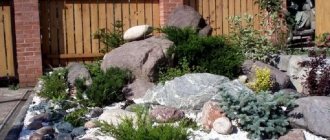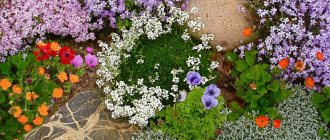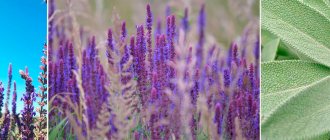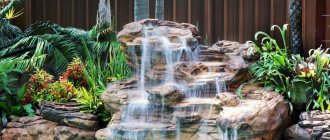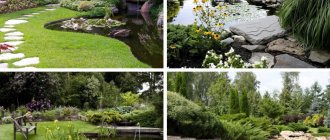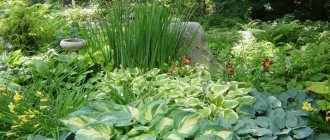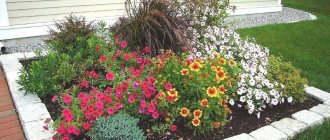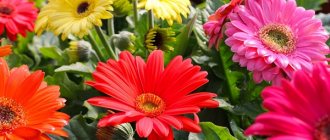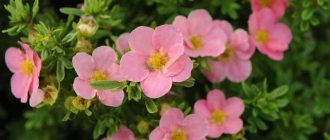DIY rock garden - it's real
Do not rush to plant plants - first you need to prepare a place for them. In short, the scheme for creating a rock garden looks like this:
- The gardener evaluates the size of the site and determines the location, area and type of hill. Since most plants need good and regular lighting, it is better to choose a “place in the sun” for them in the literal sense of the word. Areas with differences in light and shadow are ideal.
- Provide reliable drainage. Mountain flora does not tolerate stagnant water - dry soil is much preferable.
- If there are problems with the design of the rock garden, a ready-made diagram with photographs may be useful. When you select stones, keep in mind that some of them can leach the soil and oxidize it.
- The soil is poured between the stones; in most cases, it does not need to be fertilized.
- The composition will be considered ready only when it “settles” properly. To do this, you need to wait a few weeks, ideally all winter.
Annuals (usually low-growing)
For an alpine hill, low-growing annuals would look like an excellent option.
In combination with bulbous flowers, they form beautiful and colorful inflorescences that are pleasing to the eye.
The following plants can be classified as annual flowers.
You may be interested in: Design of a private house yard: how to design a landscape
Brachycoma iberisolifolia
Loves light and warmth, and water in dry periods.
Lagurus (haretail)
Thanks to this plant, you can add naturalness to your slide.
Needs frequent watering and likes sunlight. It is drought tolerant.
Notched dimorphotheca
This flower has sunny shades. The flowering period is quite long.
From perennials and annuals, you can choose those that are called blooming all summer.
Subtleties of choosing plants
Be guided by both your own preferences and climatic requirements. Low-growing and slow-growing perennials are considered the best option. This also applies to shrubs and trees.
Why are tall crops completely unsuitable for rock gardens? The fact is that they create additional shadow and prevent other species from growing. But ground cover plants for an alpine hill will be a good choice. They cover the surface, creating a general background. Just try not to plant too many ground cover plants. This will spoil the overall impression of the flower arrangement.
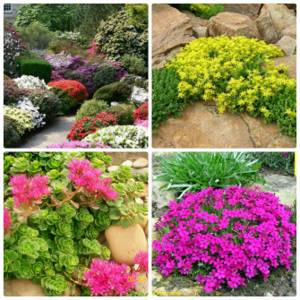
The best solution is perennial flowers for alpine hills. Plants should be planted taking into account their flowering period. This will keep the rock garden looking attractive from early spring to late autumn. The top can be planted with early flowering annuals. Coniferous shrubs will give the composition a fresh look in winter.
The artificial mountain landscape also has practical benefits. Next to ornamental plants you can plant medicinal ones - for example, sage, chamomile and thyme.
Remember these simple rules to correctly select plants for your alpine slide and protect them from death.
Functions of plants for a rocky garden and alpine slide
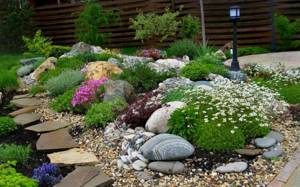
So, for example, shade-loving species are not suitable for a sunny rocky hill, etc. But when selecting plants for rocky gardens (rockeries), one more important factor must be taken into account - their naturalness, “naturalness”. On a rocky hill, lush garden flowers are inappropriate, as they distract attention from the overall composition. In addition, all plants should be compact and, if possible, look neat and beautiful all year round. Therefore, give preference to natural species and varieties similar to them, especially plants with wintering leaves and shoots that decorate the garden even in winter.
The main functions of plants for a rock garden are as follows:
- emphasize the beautiful elements of the rock garden;
- hide unsuccessful elements of the composition, ugly or unnaturally laid stones (conifers and ground cover perennials are suitable for this);
- soften and enliven the composition;
- delight the eye with a variety of colors and textures of leaves, beautiful flowering.
Plant plants in the order in which they are discussed in this article - this will help you correctly create a composition and provide the plants with the best living conditions.
Visual planting schemes
At first glance, it seems that creating an organic composition on your own is a difficult, almost impossible task. Firstly, this is not true, and if you have a working diagram at hand, there will not be any special problems. Secondly, you can always take advice from landscape design specialists. In the end, on our website there is always a sensible photograph and a detailed description of the landing schemes.
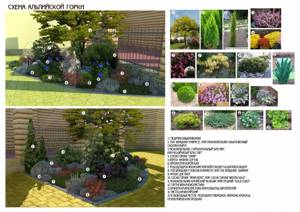
On each of the tiers you will have specific types of plants growing:
- Foot. It is best to plant species that prefer fertilized, moist soil. The list of “must have” plants includes turf pike and some other ornamental grasses, juveniles and saxifrage.
- Middle tier. Designed for less demanding representatives of mountain flora. The lighting here is a little poorer, so phlox and primroses will come in handy. To avoid the occurrence of voids, additional ground cover sedums are planted between the flowers.
- At the very top we recommend placing early flowering annuals and perennials, as well as bulbous ones. This is explained by the fact that they love dry soil and cannot develop normally without sunlight. Iberis will help make the top picturesque. From a distance they will look like a delightful white veil. You can dilute the white shade with lilac using thyme; alyssum will help add yellow. And edelweiss planted at the very top will look like a real king!

So, let's summarize. First of all, you need to plant trees and the tallest plants. There are two optimal places for them: the base and the background. As for the low perennial representatives of the flora, they can be placed anywhere. You can visually separate the tiers using medium-height plants and stones.
Perennial flowers grow relatively slowly. To prevent the area from just standing idle, you can decorate it with annuals: marigolds, purslane, and any other low-growing plants.
We also recommend reading
- Landscaping in front of the house
- Landscape design of a small summer cottage
What flowers can bloom all summer?
Marigold
They grow from summer to frost. Has many types. Loves light and warmth, has a negative attitude towards strong humidity. Photo:
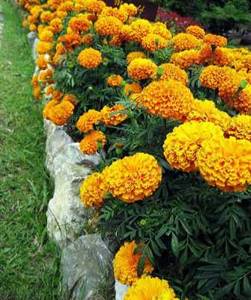
Rhodiola
It begins to bloom from spring until autumn. Sun-loving flower, lush perennial.
Balkan geranium
It is also a perennial that grows in June and closer to autumn. They are a type of long branching, forming some kind of thickets.
Periwinkle
It looks like a rug and is favorable not only to the sun, but also to the shade. Grows from May to September.
Crimson arena
The color is similar to the name - crimson. This flower is very drought resistant. Considering the fact that it can grow not only on sand, but also on stones, it is perfect for a slide.
You may be interested in: Flowering ornamental shrubs in a personal plot: which ones to choose, planting rules
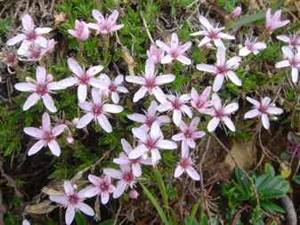
Below you can see what the color scheme looks like:
Which coniferous plants to choose for a rock garden?
Among the abundance of coniferous plants, we recommend choosing and planting the following varieties: western thuja, common and Canadian spruce (also called gray spruce), Korean fir and junipers. Keep in mind that the height of coniferous trees for an artificial flower garden, regardless of its type and shape, should not exceed 70 centimeters. You can combine them as you like, creating contrast in shape and color or making smooth transitions.
Follow these recommendations so that coniferous shrubs and trees become a worthy decoration of your corner of nature.
Herbaceous plants for the hill: name, description, photo
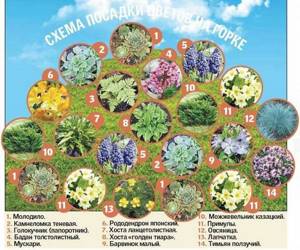
Let's find out exactly which herbaceous plants gardeners and landscape designers recommend using when it comes to an alpine hill and its arrangement.
Periwinkle
Pay attention to the photo - the plant has bright blue flowers, creating good volume along with green leaves. The plant is absolutely unpretentious in care, feels great in the sun and in shaded places. Using it, you can create a very lush, incredibly bright carpet. Typically, periwinkle begins to bloom in May and ends in September-October.
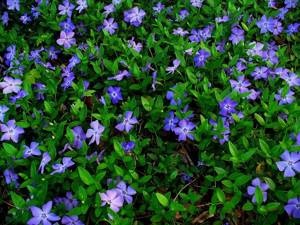
Saxifrage
Saxifraga is a perennial that can grow even in the harshest conditions. Even where there are ordinary stones instead of soil, saxifrage will feel quite comfortable. By the way, this is where the name comes from. The photo clearly demonstrates that on an alpine hill plants such as saxifrage can have a wide variety of color shades. In total, there are almost 370 species in nature.
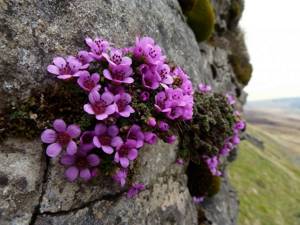
Soddy pike
Ornamental grass, the second name of which is “meadow grass”. It looks like a very dense hummock with hard leaves and spikelet inflorescences in the form of a panicle. Pike loves moisture, but an arid climate can be disastrous for it. There are various types of pike in nature, with varied colors. It begins its growth in April-May, it slows down in the summer, and is restored again in the rainy autumn.
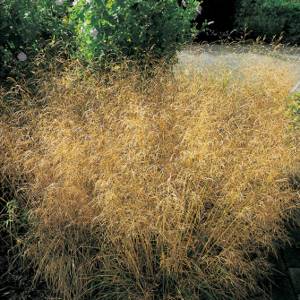
Soldanella
Spanish name, which literally translates as “small coins.” A variety of mountain flowers also called snowbells. The size is relatively small, blue and white peduncles are most often found. Soldanella loves moisture, so you definitely can’t do without moist soil and reliable drainage. However, not every flower can compare with it in attractive appearance.
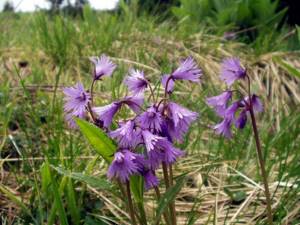
Asparagus
In general, there are about 300 varieties of asparagus. In our country it is sometimes called “asparagus”. You will immediately recognize asparagus by its thick, needle-like greenery. The inflorescences are small white flowers, bright red berries. It is best to take whorled or spherical asparagus for a rock garden, the bushes of which are more compact.
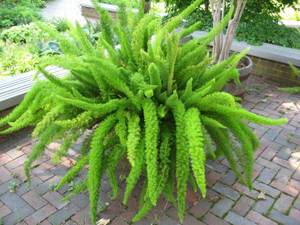
Sunshine
It is a low bush with creeping stems. The leaves are gray-pubescent, the flowers are yellow, pink and orange. Sunshine loves alkaline and sandy soil. The plant is a young plant and is propagated by cuttings. Coin sunshine is the most popular species found in landscape design.
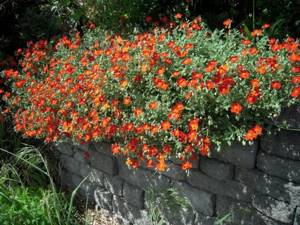
Grouse
The hazel grouse is not only a bird, but also a wonderful bulbous plant. It got its name because of its truly variegated color. In gardening, you can most often find fritillaria with bells hanging down. Among the low varieties, hazel grouse Alba and Aphrodite attract attention.
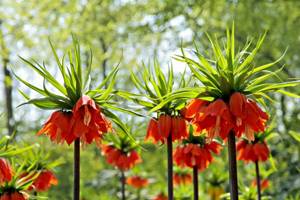
Pushkinia
We continue to tell you about plants for alpine hills with photos and names. Next up is Pushkinia. The plant is bulbous and blooms in early spring. The first flowers of the forest-like Pushkinia can be seen in March-April, while the hyacinth blooms mainly in May.

Bladderwort physalis
A perennial with leaves, the height of the bushes reaches 20 cm. The flowers are purple and are collected at the top in the form of an umbrella. The bladderwort is very unpretentious in care and loves the sun. It begins to bloom in April, after which the seeds appear. However, the main highlight of this plant is its unusually shaped leaves.

Poultry farmer
There are more than 120 species of poultry grass; bushes with small white or yellow flowers are used in landscape design. Very easy to care for, prefers sunny areas. Completely undemanding to soil.
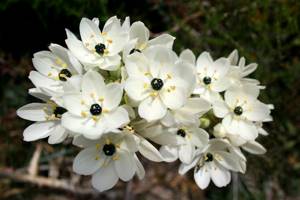
Lumbago
Whatever perennial plants you choose for alpine hills, there must be sleep grass on the site. This is what people call lumbago. This plant has straight leaves and stems that are covered with small hairs. The height of the plant is 30-40, but not more than 50 centimeters. The flowers are very large, shaped like a bell. The color scheme is quite varied: golden, violet, purple and silver shades.
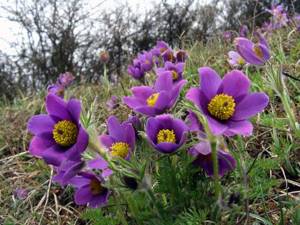
Edelweiss alpine
That same romantic plant that symbolizes love and fidelity. Despite the relatively small size (height - 15-20 cm), the yellowish inflorescences-baskets of edelweiss are visible from afar. The star-shaped leaves also look charming. Be sure to decorate your landscape with this plant!
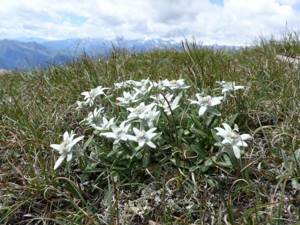
Linen
Since there are several varieties of flax, it can be annual or perennial, as well as a subshrub. 20 species are used in landscape design, mostly large-flowered flax. Thanks to its delicate shades, linen looks great against the background of gray stones. Loves sunlit places, a little shade is allowed.
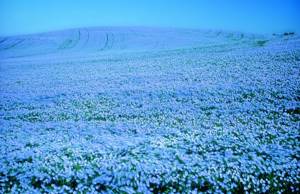
Of course, these are not all the plants that are planted on alpine hills and decorate them with their splendor. There are also cinquefoil, iberis, alyssum, and young ones. Combine different types, do not hesitate to imagine and be creative - you will definitely succeed!
Perennial flowers recommended for rock gardens
One of the most common options for planting flowers for a rock garden are perennial flowers. This is due to the fact that they have a high density of inflorescences, a long flowering period, low maintenance, and are resistant to frost and drought. Among other things, with proper care, they can bloom more than once.
Of course, there are some features that are worth considering: the presence of sunlight, the absence of strong moisture in the soil.
Below is a list and photos of some flowers of this variety.
Carnation
Their highlight is the formation of a clump and lush flowering.
This flower is divided into subspecies, which grow alternately:
- first the grass;
- then, around June, the cirrus and alpine types.
You may be interested in: Office landscaping and phytodesign of the work space
Echinacea
It has flowers that are rich in color and large in size. This plant is quite hardy and drought resistant. Loves sunlight and nutritious soil.
It begins to bloom in mid-summer and can replace flowers that have already faded. Example in the photo.
Primorskaya army
It looks like a bush with ball-shaped inflorescences. Refers to long-flowering species.
It is quite resistant to cold periods, as well as aridity. Does not like strong humidity. Photo:
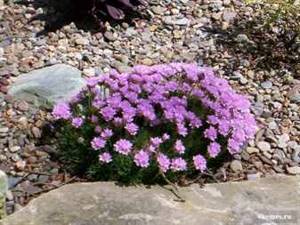
Alyssum (rock alyssum)
They have a golden hue and form lush inflorescences. The flowering period begins in May.
This plant is drought tolerant and loves sun. Here is his photo:
Stone rose (rejuvenated)
Its peculiarity is the strengthening of stones in the narrowest crevices.
Its shapes and colors are amazing in variety. In the latter version, it changes color depending on the season.
Highlander (edelweiss)
It is important to decorate the top part of the rock garden with this flower. Loves sunlight.
What is noteworthy is that it is in the famous red book. But there is no need to be afraid, since it is possible to grow it with your own hands.
Tips for planting flowers on an alpine hill
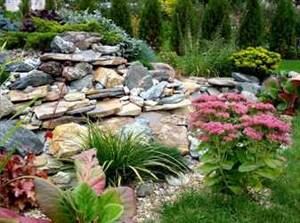
What flowers to plant in your rock garden depends on the taste and desire of each person. To begin with, you should formulate the final version in your mind, thinking in detail about how this or that flower will take root, where and at what angle of light to plant it, when to water it, or not to touch it at all.
One of the options for creating a beautiful flower garden in the country may be the Provence style. As is known, it has existed for quite a long time, and still amazes everyone with its beauty, bestows bliss and romance.
The principle of any planting to achieve proper flowering and beauty must correspond to the presence of different varieties of flowers, which tend to alternate in their bloom in a certain period of time. This is necessary so that the pot does not turn out to be made only of stones. Of course, everything is not for everyone.
To complete the picture, it is worth paying attention to:
- for flowers growing in early spring;
- for varieties that bloom in summer;
- on flowers growing in late autumn.
The combination of these features will help maintain the beauty of the alpine slide in balance.

